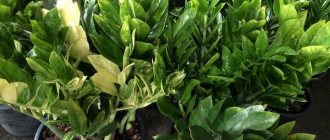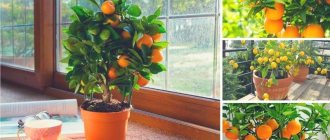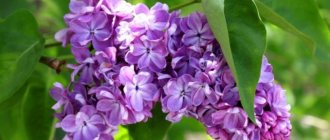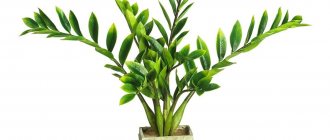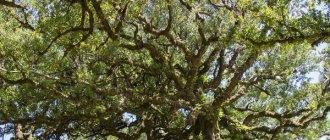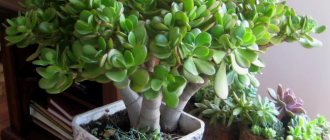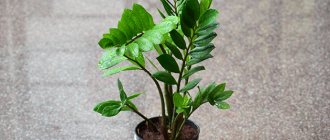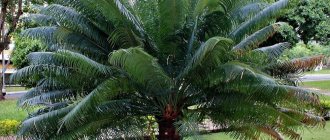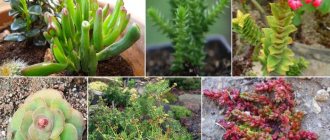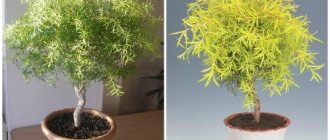Flower growers are happy to grow ardisia indoors. This representative of the Marsin family received another name for its spectacular and bright bunches of berries - coral tree.
In the wild, trees are found everywhere in the tropics and subtropics, differing from each other in height, shape and shade of flowers and berries. But they have one common feature - the fruits stay on the home bush for up to a year, while decorating the room with unusually bright colors.
Home care
There should not be any particular problems in growing ardisia, since it is quite unpretentious. You just need to know what conditions are acceptable for a tropical plant and strictly follow them.
Location and lighting
There should be a lot of light, but it must be diffused. Therefore, it is better not to choose southern windows for a pot, giving preference to western or eastern ones. The scorching rays of the sun in summer can cause burns on the leaves. If you still choose a south window, then shade the bush in the warm season.
Temperature
In summer, moderate heat is preferable - +20-25°C. In winter, the air should be much cooler - within + 14-16°C. It is during this period that the buds are laid. If it gets hotter, they will either fall off, or the flowering will be weak and sparse.
Just don't overdo it with coolness. If the air cools to +7 degrees, this can lead to the death of the pet.
Watering
Ardisia should be watered regularly, especially during flowering and fruiting. Make sure that the earthen ball does not dry out. As soon as the top substrate dries a little, immediately splash some water. But do not overwater, so that the root system does not begin to rot.
In summer, on average, you will have to water every other day or two. In winter, once or twice a week will be enough.
Air humidity
The ideal humidity for a woody tropical plant is 55%. In principle, it is not difficult to achieve. Try to spray the bush more often with settled water at room temperature. This way you will not only increase air humidity, but also prevent the appearance of spider mites.
When ardisia blooms, stop spraying. At this time, it is better to wipe the leaves with a damp and well-wrung cloth. You can start spraying the plant again only after setting the berries. If the room is too dry, the flowers will quickly fall off.
The soil
Neutral soil is suitable for growing. It should be loose, well breathable, and enriched with nutrients. So it is recommended to buy the substrate at a flower shop.
But if you are used to doing everything yourself, prepare the following soil mixture:
- 33% deciduous land;
- 33% river sand;
- 33% peat;
- 1% sphagnum or charcoal.
Feeding and fertilizers
Feed your pet with complex mineral fertilizers once every 15 days. Start doing this in early spring and continue until late autumn. Leave the plant dormant in winter.
Transfer
The ardisia will signal you that the time has come to transplant it into a larger flowerpot with its roots crawling out. In principle, transplantation can be carried out at any time of the year. But it is better to do this at the end of February - beginning of March.
Choose a pot that is not much larger in size than the previous one. If it is too spacious, the coral tree will throw out a weak color. Be sure to line the bottom of the container with a drainage layer of expanded clay, broken brick or small pebbles. Cover it with a layer of substrate.
Remove the bush from the old pot along with the earthen lump. Do this very carefully so as not to damage the roots. Having placed it in a new pot, fill the resulting gaps with prepared soil.
While the plant is young, replant it every year. When it comes into force, the intervals between transfers can be increased.
Trimming
To prevent the flower from stretching upward, but to have a compact, beautiful shape, it should be pinched in the spring (before flowering begins). Then the bush will become more magnificent and will look more aesthetically pleasing. When pruning, mercilessly get rid of damaged, weak and too old shoots.
Containment conditions: table
For ardisia, the following conditions should be created depending on the season:
| Season | Optimal temperature conditions | Lighting | Accommodation |
| Spring, summer and autumn | The temperature should be within +20…24°C | The plant loves diffused light and should not be exposed to direct sunlight. | It is recommended to place the pot with the plant on the southeast or southwest side |
| Winter | It is advisable to reduce the temperature to +15…18°C. It is necessary to ensure that the thermometer does not fall below +7°C | It will be necessary to provide additional lighting using a fluorescent lamp | Ardisia should be removed away from heating appliances |
Bloom
Ardisia blooms with small flowers. They can be white, pink or red. The flowers are collected in umbrellas or panicles.
The flowering process begins in late spring or early summer. Protect your ward from drafts so that the buds do not fall off. During this period, water more often than usual. In autumn, until December, small fruits ripen. They can stay on the plant for up to a year. The berries are not poisonous, but it is better not to eat them.
Trimming
Pruning should be done annually. It is used to form a crown (the shape can be any) and remove old, diseased and yellowed shoots. Important: the foliage has one peculiarity - there are small “swells” at the edges. These “pockets” contain symbiotic bacteria that help absorb nitrogen. You should not pick them off; the presence of tubercles is a sign of a healthy, not a diseased plant. Without these bacteria it will die.
To achieve more luxuriant flowering, you can use special preparations - retardants. They will also be growth inhibitors and will prevent the stems from stretching upward excessively.
Reproduction
Guests from the tropics can be propagated in two ways: using cuttings or seeds. At the same time, cutting cuttings is very troublesome, so only experienced gardeners can do it. For amateurs and beginning flower lovers, it is better to sow seeds. This should be done in spring or summer.
Cuttings
When pruning, the tops of the shoots do not need to be thrown away, but rather planted in small containers. Before sending for rooting, treat with a root-forming agent, for example, kornevin. The substrate in the pot should be heated to +26 degrees. The sprouts should be kept in diffused light. The air should be heated to +25 degrees.
When the seedlings take root, plant them in a permanent place. It will take a long time for the roots to appear, so be patient.
Seeds
It is much easier to get new ardisias from seeds. In January, select berries on the bush with a volume of at least 1 cm. Separate the pulp, saw off the seeds and soak in a solution that stimulates growth, and then place them in a damp soil mixture. Planting depth is about one centimeter. Set up a mini-greenhouse by covering the container on top with glass or stretching film. Place in a warm place. After about 40 days, the first shoots should appear.
Wait until they get stronger and plant them in separate pots, filling them with soil mixture. You will have to wait 2-3 years for the moment of flowering.
The seeds do not last long, so plant them as soon as possible, without waiting for spring.
Popular varieties
There are about 500 varieties of ardisia in the world. At home, gardeners most often grow the following:
- Ardisia crenate (Crenata).
This type is the most common. The indoor plant reaches a height of no more than 1.2 m. It is distinguished by glossy malachite-colored leaves.
- Ardisia is low.
The plant grows up to 60 cm in height and is covered with large leaves of rich green color. Its distinctive feature is the red-brown berries, which turn black as they ripen.
- Ardisia japonica.
This low-growing shrub reaches a height of no more than 40 cm. It has oval leaves, pointed at the ends. During flowering, the plant produces cream flowers.
Diseases and pests
Most often, ardisia suffers from chlorosis. This fungus “paints” a light mesh on the leaves. It develops from a lack of iron in the soil. So, in order to prevent the disease, apply fertilizers that contain iron preparations more often.
Cherevtsy may attack. In this case, the soil should be replaced with new one and the bush should be treated with an insecticide.
Among the pests seen on evergreen plants are also:
- scale insect;
- aphid;
- spider mite
All of them can be gotten rid of with the help of insecticidal preparations. It is imperative to combat pests, as they not only spoil the appearance of the bush, but can cause its death.
Problems when growing ardisia
- Along the edges of the leaves you can find tubercles - this is the residence of beneficial bacteria that contribute to the absorption of nitrogen. They should not be deleted under any circumstances.
- The tips of ardisia leaves begin to dry out from high humidity or exposure to a draft.
- The appearance of white spots on the leaves indicates sunburn - it must be protected from direct sunlight.
- The tips of the leaves turn yellow from lack of light or nutrition. Provide proper lighting. If the leaves turn yellow even when they are in a bright place, it means that it is necessary to increase the dose of fertilizing with mineral fertilizers.
What to do if you flooded with ardisia
If you overdo it with watering, the Christmas tree will certainly begin to rot. In this case, you cannot hesitate: urgent resuscitation is needed. Cut fruits and flowers, you can remove the lower leaves from the branches. Free the roots from the pot, inspect them carefully, cut off all rotten parts with a knife, treat with a weak solution of potassium permanganate (you can place the plant in a pinkish solution for 20-30 minutes).
After this, let the water drain and start replanting. Prepare a spacious pot (you can take an old one, but treat it with boiling water or potassium permanganate), fill it with a drainage layer and new soil, and carefully plant the plant. There is no need to water immediately; let the roots heal the wounds a little. A day or two after transplantation, water the ardisia with a solution of phytosporin (this is a biofungicide that will help fight rot).
In the future, water through the pan, making sure that the soil is just damp.
Care errors
Those who ignore proper care of ardisia will have to face various problems.
- Dry brown spots on leaves. Appear due to sunburn. Shade the plant with white paper or tulle. This may also be a consequence of too high air humidity or stagnant moisture in the root system.
- The leaves began to turn yellow. The bush lacks nutrients, especially nitrogen, and the air humidity is too low. Spray the foliage and fertilize.
- The leaves have turned brown at the edges. Problems with watering: it is excessive or, on the contrary, insufficient. Please resolve this issue.
- The leaves have become soft and curled. Too large temperature fluctuations during the day or a cold draft caused trouble. Address these shortcomings.
- Faded leaves and elongated stems. The pet is experiencing a lack of light. In winter, daylight hours should be increased by artificial lighting. If this happens in the summer, take the pot outside, placing it in a quiet, windless place.
- Soft and saggy foliage. Talks about the need to urgently water.
Benefits and harms
Ardisia is not toxic.
The berries are inedible, but if accidentally swallowed they will not cause harm. For example, in China, the fruits are considered medicinal and are used for arthritis, snake bites and injuries. Ardisia is perfect for decorating rooms. The tree looks most beautiful in winter, so the Christmas berry will be a good gift for family and friends during the New Year holidays.
Attention. Ardisia lives in symbiosis with certain bacteria
Small nodules filled with microorganisms form on the leaves. This is not a disease. Bacteria help the plant get the nutrients it needs.
Folk signs
Attentive people find a lot in common in the appearance of clusters of ardisia and rowan berries. Therefore, the Japanese rowan is also considered a widow's tree. They say that wives often plant colorful flowers on the graves of husbands who have died prematurely.
But there are also good signs.
It has long been believed that a necklace made of coral berries will protect you from all sorts of troubles. It will give courage to warriors, and beauty to young maidens.
Having placed the pot on the window of your house, rest assured: the plant will protect you from an unkind eye and an evil word. And an atmosphere of warmth, peace and mutual understanding will reign in the family.
Medicinal properties
The Chinese successfully use extracts obtained from fruits, roots and leaves to treat infectious diseases of the respiratory system. They are used for injuries and rheumatoid arthritis. The berries are believed to help with snake bites.
Just don’t even think about decorating your children’s room with this flower. When a child sees large red berries, he will definitely want to eat them, which can lead to allergies.
Kinds
There are up to eight hundred varieties of Ardisia. The most common are the following.
Gorodchataya
Flower growers grow this species most often. A powerful plant can stretch up to 2 m. Although it does not grow too fast. Beautiful clusters of fruits stay on the bush for up to a year. The leaves are also impressive with their wavy edges. The flowers are predominantly pink, but sometimes white.
Curly
Usually this bush does not grow higher than 80 cm. Small cream flowers gather in panicles and bloom very luxuriantly. Despite the fact that there are still ripe coral berries on the neighboring stems. The leaves have a wavy edge and are shiny.
Low
The most compact species with 15 cm dark green leaves and light pink drooping flowers. The berries are initially red-brown in color, but as they ripen they turn black and shine beautifully.
Solanacea
The leaves are pale green and the shoots are light red in color. They are not as wide as those of previous comrades. Purple or pink small flowers cannot charm anyone. But when the berries appear, they are initially pale red in color, and over time they darken and become shiny.
Elliptical
A bush with pinkish flowers and red berries ripening in their place. Over time they turn purple.
What's interesting about Ardisia
From Greek, the name of the indoor tree is translated as “arrow”. People call it the “Christmas tree” because its fruits ripen at the end of December. Flower growers fell in love with this plant because it retains its decorative qualities almost all year round.
In nature, exotic grows in the tropics of America, as well as in the forests of Asia and the Pacific Islands. Ardisia can take the form of a tree, shrub or subshrub. Most often, its height does not exceed two meters, but some varieties can reach eight.
Ardisia, grown at home, is a compact tree with glossy dark green leaves. They have the shape of an elongated “boat” with wavy edges. The perennial plant blooms with small arrow-like flowers. Flowering gives way to small cream-colored berries. As they ripen, they acquire a rich red color and do not fall off for several months. The berries leave behind one seed at a time.
How to choose ardisia
When going to the store for this coral miracle, be sure to make sure that they offer you a quality copy:
- If the roots are visible, they should be clean, without rotten rot or any damage.
- Make sure there are no bugs or larvae in the substrate.
- The leaves should not be dry, damaged, yellow or limp.
- In addition to blooming flowers, look for buds. During a move, a plant may drop its flowers due to stress, and the buds will bloom after some time.
Happy shopping!
Be sure to make room in your green corner for this plant with wonderful berries. Ardisia will become a year-round decoration for your home. And in winter, contemplating its bright berries, you can avoid depression.
Transfer
Young shrubs (up to 3 years old) are replanted annually. In the future, the transplant is used as needed. Please note: even if the roots have filled the entire volume of the pot, do not rush to replant the flower. It is believed that in such conditions the plant grows more magnificently and better. It is enough to change the top layer (1 cm) annually and postpone replanting until the roots begin to “burst” the pot.
Replanting should be done very carefully, using the transshipment method. Although the transplant is generally well tolerated, the roots must be kept intact. To prevent their diseases, it is better to calcinate the soil mixture or treat it with boiling water.
